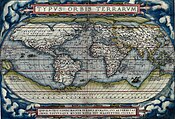
Geography
Study of lands and inhabitants of Earth / From Wikipedia, the free encyclopedia
Dear Wikiwand AI, let's keep it short by simply answering these key questions:
Can you list the top facts and stats about Geography?
Summarize this article for a 10 years old
Geography (from Greek: γεωγραφία, geographia. Combination of Greek words 'Geo' (The Earth) and 'Graphien' (to describe), literally "earth description") is a field of science devoted to the study of the lands, features, inhabitants, and phenomena of Earth.[1] Geography is an all-encompassing discipline that seeks an understanding of Earth and its human and natural complexities—not merely where objects are, but also how they have changed and come to be. While geography is specific to Earth, many concepts can be applied more broadly to other celestial bodies in the field of planetary science.[2] Geography has been called "a bridge between natural science and social science disciplines."[3]
| Part of a series on |
| Geography |
|---|
 |
| Portal |

.svg/440px-World_Map_(political).svg.png)
The first recorded use of the word γεωγραφία was as a title of a book by Greek scholar Eratosthenes (276–194 BC).[1] However, the concepts of geography (such as cartography) date back to the earliest attempts to understand the world spatially, with the earliest example of an attempted world map dating to the 9th century BCE in ancient Babylon.[4] The history of geography as a discipline spans cultures and millennia, being independently developed by multiple groups, and cross-pollinated by trade between these groups. The core concepts of geography consistent between all approaches are a focus on space, place, time, and scale.[5][6][7][8][9][10]
Today, geography is an extremely broad discipline with multiple approaches and modalities. There have been multiple attempts to organize the discipline, including the four traditions of geography, and into branches.[11][3][12] Techniques employed can generally be broken down into quantitative[13] and qualitative[14] approaches, with many studies taking mixed-methods approaches.[15] Common techniques include cartography, remote sensing, interviews, and surveys.